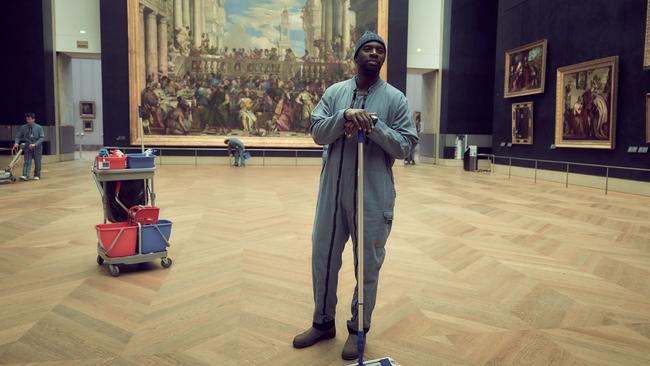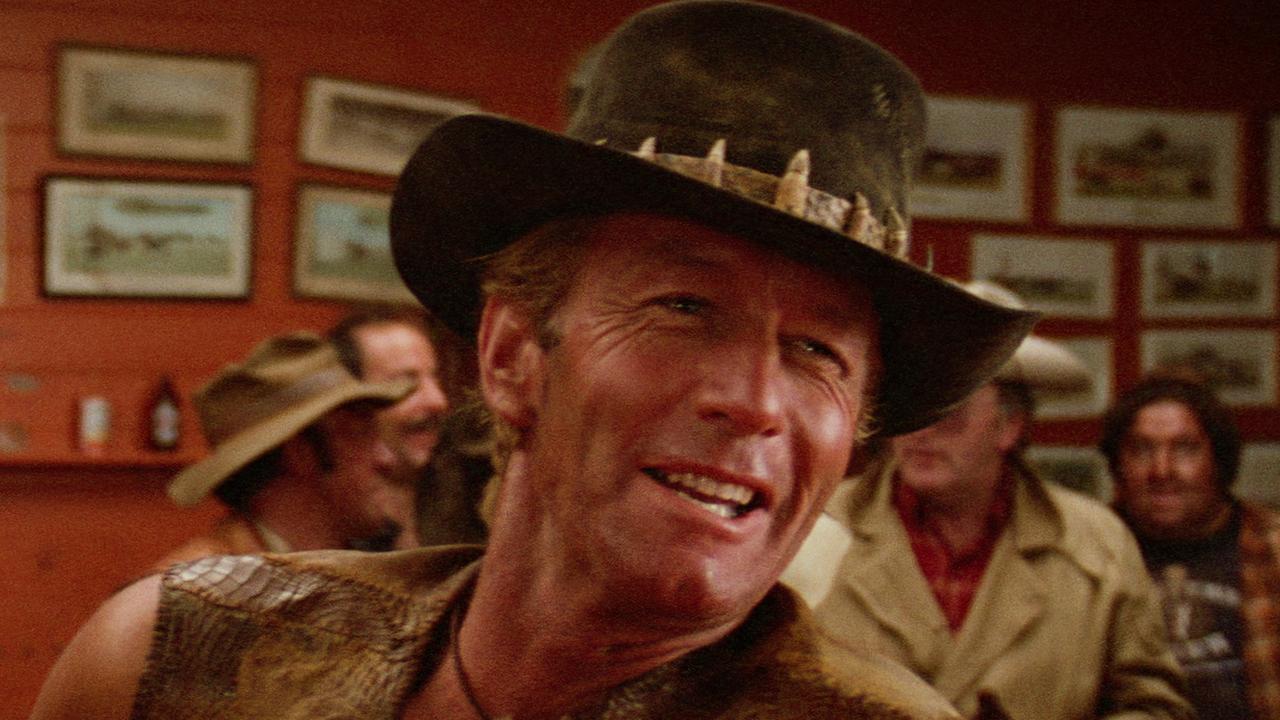Lupin not just playing by the book
Hot on the heels of Bridgerton, Netflix’s next big hit series Lupin has made its leading man, Omar Sy, an international star.

It seemed to come from nowhere, hardly promoted and with little discernible advance publicity. But within weeks, even after the seductively entertaining Bridgerton had become a controversial media sensation, the brilliant French language crime series Lupin had become Netflix’s biggest original series. It made its leading man, Omar Sy, already a legend in France for the box office hit The Intouchables, into an international star, winning rave reviews for his performance as gentleman thief Assane Diop.
Since its release, it has reached well over 70 million households, bigger than not only Bridgerton but also The Queen’s Gambit. I’ve only just caught it, bingeing this stylish and so cleverly self-aware piece of TV in an evening of delight as many of you may have already done.
It was created by the suddenly very visible George Kay, in collaboration with French comedy writer Francois Uzan. Kay, who dominates the publicity and appears to have had the original idea, is a British writer and producer who most recently co-created the brilliant Netflix procedural series Criminal, a cop drama built around interrogation, questioning the moral effectiveness of the law and justice system from an intense psychological perspective in four different counties.
It is an intense watch, too, with the drama built around an incessant play of furtive meanings and ambivalences. Lupin couldn’t be more different, a comedy mystery caper drama drawing on the French attitude to both immigration and racism while at the same time celebrating the mystique of literary legacy.
The show follows Diop, a Senegalese immigrant brought to Paris as a child by his father Babakar (a lovely restrained performance by Fargass Assande) for a less impoverished life, as events conspire to propel him into what becomes a story of revenge.
The narrative as it plays out in cleverly pitched flashbacks is shaped by a book containing the adventures of the fictional thief Arsene Lupin written a century earlier, and given to the hulking Diop by his father before Babakar is framed for stealing the priceless Queen’s Necklace from the wealthy and corrupt Pellegrini family for which he works. His father commits suicide in prison, his son laden by a legacy of calamity from which his adoption of the persona of Lupin redeems him.
It’s a clever, witty and very meta twist, self-reflective and self-referencing actual source material about a fictional character who attacks the rich, stealing their purses along with their secrets, widely regarded as one of France’s most famous literary creations. (Sy, already under contract to Gaumont Television, which produces Lupin, when asked by the producers to select his dream role as they considered projects for him, “If I were British, I would have said James Bond, but since I’m French, I said Lupin.”)
Created as a consequence of the popularity of Sherlock Holmes, which surged throughout Europe and America towards the end of the 19th century, Arsene Lupin, was a gentleman thief moonlighting on occasions as a detective created by French writer Maurice Leblanc. Epitome of the Belle Epoque dandy, Lupin first appeared in a short story published in July 1905 in the magazine Je sais tout (“I know all”) and quickly became a sensation as well as an archetype declared at the time by one stylish magazine as “dernier cri”, the latest fashion.
From 1905 to 1939, Leblanc wrote him into seven novels and 39 novellas, co-authored several plays featuring his hero, turning the monocled Lupin into a venerable mainstay of French culture, appearing in films, TV shows, even crossing to Hollywood in the 1930s and to Japan in the late 1970s in Miyazaki Hayao’s feature action-comedy adaptation Lupin the Third.
And Kay, who wrote several episodes of the wonderful first series of the deliciously twisted Killing Eve, another series featuring disguises, fabulous outfits, chases and personal reinvention, imbues the whole caboodle with the same kind of criminal impudence and comic outrageousness.
He’s wittily assisted by the talent of veteran action director Louis Letterier, best known internationally for the first two hit Transporter action thrillers, and the CGI-heavy reincarnation of The Incredible Hulk.
Letterier is all over this production, expert at using pace to generate energy, breaking scenes up into many visceral shots, operating the camera himself at times it seems looking at the behind-the-scenes Netflix footage, the action gaining a cumulative momentum.
It’s a lovely series to look at, Letterier’s direction at times delightfully ethereal and graceful. Just like his star.
Kay’s idea was inspired. While the Arsene novels had been adapted many times he believed he could bring new life to the style and tone of the original books through a reimagined characterisation of the suave thief, escape artist, and master of disguise. Kay told Variety he knew he wanted to keep the sense of “mischievous, adventurous crooks and criminals intersecting establishment”, but he felt it was equally important to “take everything we loved in the books, subvert it, update it and create a really modern story through the heart of it”.
The original works are used as a source of inspiration for his leading man Assane, who devours them like religious texts, as well as the tumultuous events and even locations of the first 10 episodes, including the first heist story that dominates the initial episode in rollicking action movie style.
Diop decides to steal back Marie Antoinette’s necklace, the one that resulted in his father’s death, when it resurfaces for the first time in more than a decade. Inveigling the help of local gangsters, he infiltrates the Louvre as both a lowly janitor, after casing out the museum and spending time with the Mona Lisa, and also in disguise as a wealthy art patron there for the public auction of the necklace. “It’s worth a thousand years of minimum wages,” a black maintenance colleague tells him as he earlier insinuates himself into the museum.
Letterier, as he does throughout the series, makes great use of the iconography of the Parisian landscape, not only the Louvre, the other star of the first episode, with sublime shots of the illuminated leoh Ming Pei Pyramid and Montmartre’s Sacre-Coeur Basilica featured in a visceral high speed chase across Paris’s zinc and slate rooftops. And our gentleman thief makes an astonishing escape from the Luxembourg Gardens, between Saint-Germain-des-Pres and the Latin Quarter, utilizing its diametric lines and angles to somehow escape on a bicycle disguised as a food carrier.
The first five episodes are with us, ending somewhat surprisingly with a brilliant cliffhanger that has you throwing the remote at the screen as you shout, “More, I want more now”. This narrative turning point is set at Normandy’s Étretat beach - an homage to fans of Leblanc’s character, specifically the 1909 Lupin book, The Hollow Needle, the promenade jammed with aficionados wearing Lupin’s original costume of top hat and flowing black cape.
But Kay it seems always intended the break in the propulsive narrative, the second five episodes to follow quickly, all designed as a kind of origin story, the first chapter of something bigger. This is the back story of Kay’s Assane Diop that in its final five chapters will tell us how he got to this point in his life and then the series which will undoubtedly continue – rather like Leblanc’s many Lupin adventures – will tell us what happened in the gap between him being 15 years old when we first meet him in the early episodes and being 40.
“So we’re kind of retrospectively educating with this huge backstory,” Kay says. His Assane, while like the original “a man of a thousand disguises: in turn a chauffeur, detective, bookmaker, Russian physician, Spanish bullfighter, commercial traveler, robust youth, or decrepit old man”, as the narrator of the first novel tells us, is also a kind of knight errant with an action-oriented code of honour whose moral code enables him to act in a violent world without losing his moral force.
Like Leblanc’s original, Diop practices burglary with gallantry. This of course is given extra dimension in storytelling terms because of Assane’s race, a hard-boiled outsider with a soft heart, who criminally penetrates the Establishment that he robs from within, often of property gained in the first place illegally or immorally. He knows from long experience that that evil is endemic in the well-heeled social order.
A gleaming and deceptive façade hides a world of exploitation and criminality shot through with undertones of betrayal and danger, epitomised by the evil Pellegrini patriarch. “Assane is defined by a sense of injustice – the fact of being ignored, of being invisible – which has become his trauma,” says Sy. “He uses that. As he changes costumes and trades, he blends in with the crowd.” His ability to stay concealed, invisible among people is like his superpower, exploiting the implicit racial biases of the French. “You didn’t look at me; you saw me, but you didn’t look at me,” he tells the white thugs he outwits in persuading them to take part in the heist.
Sy’s performance is magnificent, a beast of a man with a wonderful lightness and charm. He has the gift the director Mike Nichols once called that “deal where you do nothing and it turns out you were doing everything. That’s what a great movie actor does. They don’t know how they do it, and I don’t know how they do it.”
Lupin is streaming on Netflix.




To join the conversation, please log in. Don't have an account? Register
Join the conversation, you are commenting as Logout